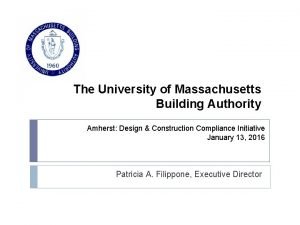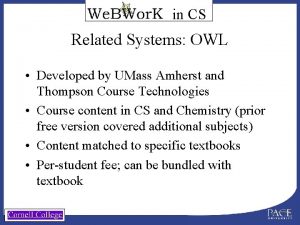Sensor Network Research University of Massachusetts Amherst UltraLow

- Slides: 1

Sensor Network Research University of Massachusetts, Amherst Ultra-Low Power Data Storage for Sensors Gaurav Mathur, Peter Desnoyers, Deepak Ganesan and Prashant Shenoy Introduction: Each generation of sensor platforms reduces computation and communication costs, but storage costs have not tracked this trend. Telos Mica 2 Storage Efficiency Applications working with high data volumes: § Camera sensor networks § Acoustic § Tracking networks for animals, vehicles, etc. § Seismic § Biological sensor networks Mica. Z Mica Computation & Communication Efficiency What is the most energy-efficient storage platform for sensor devices ? How does the energy cost of storage compare to that of computation and communication ? What are the implications of an ultra-low power storage subsystem on sensor net design ? Measurement Study of Storage Technology NAND flash based Storage Framework for Sensor Devices Toshiba Parallel NAND flash adapter Mica 2 Atmel serial NOR flash Telos. B STM serial NOR flash MMC adapter § Compare MMC, NOR & NAND flash technology § Measure active & sleep mode power consumption Motivation Existing storage interfaces § File systems - YAFFS, ELF, YAFFS 2 But… sensors do not operate on files § Stream storage and indexing – Micro. Hash Other sensor application requirements § Easy access to archived data for query processing § Support for data consistency § Hardware independence § Overcome memory constraints of platforms Application Comparison of the per byte cost of operations Device Mica 2 NOR Telos. B NOR Hitachi MMC Parallel NAND Read 0. 26* 0. 056* 0. 144 0. 004* Write 4. 3* 0. 127* 0. 659 0. 009* Erase 2. 36 0. 185 0. 0033 0. 004 Total 6. 92 0. 368 0. 806 0. 017 Index Object Stream Object Stack object . . . Transaction objects Root Directory Chunk Storage Management Layer Management * Without ECC. Cost of performing ECC in software is approx 0. 026 u. J/byte Comparison of computation, communication and storage costs TI MSP 430 instruction Energy Ratio 0. 008 1* Toshiba NAND read 0. 004 5 Toshiba NAND write 0. 009 11 CC 2420 CC 242 Radio Tx Rx 1. 8 2. 1 2250 2600 § Parallel NAND flash most energy efficient § More than 200 times less in comparison to communication costs § Comparable to computation costs § Enables ultra-low power, almost infinite storage (~1 GB) for sensors NAND flash and Driver Features § Storage object interface exposed to applications – stream, stack, queue, index, array § Implemented on NAND flash § Support concurrent data streams § Minimal memory footprint § Transaction support (atomic and durable) § Data prioritization http: //sensors. cs. umass. edu/projects/essense

